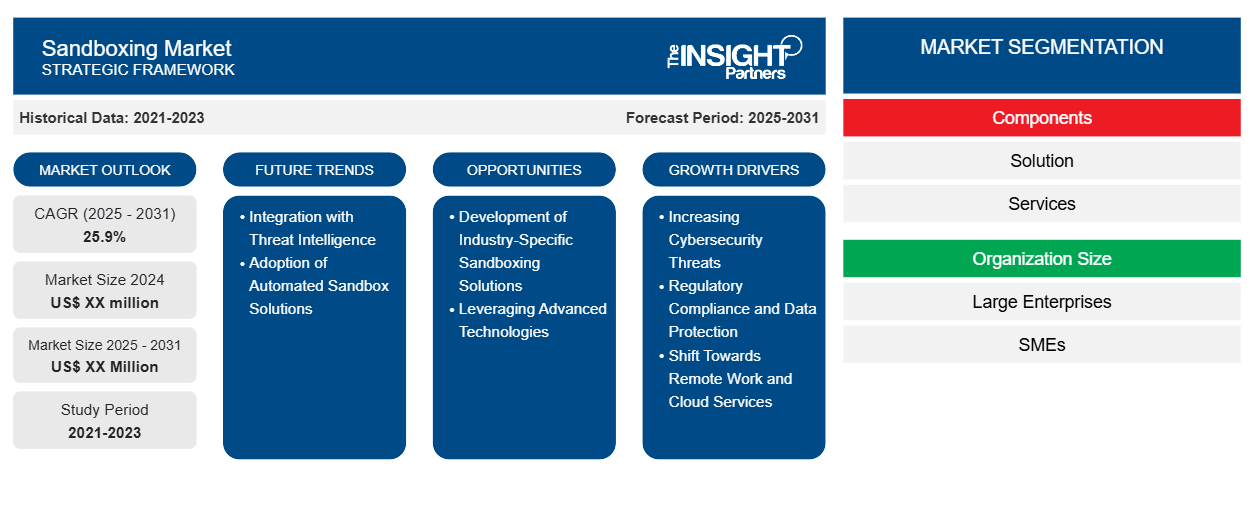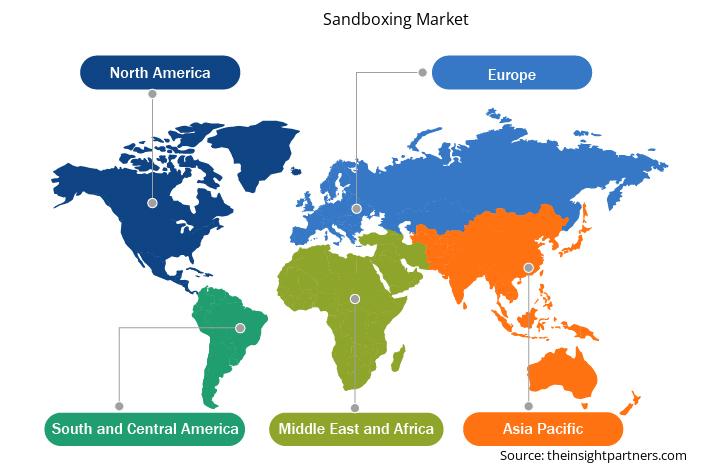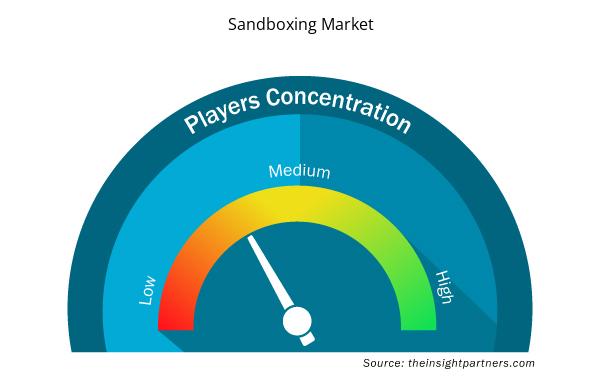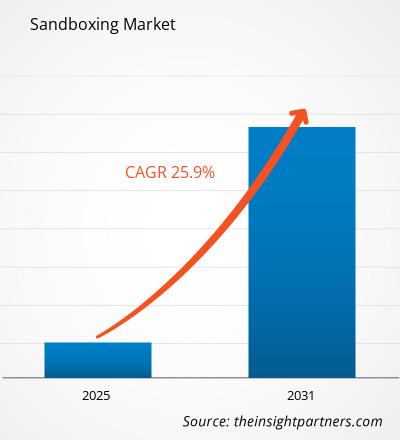The Sandboxing Market is expected to register a CAGR of 25.9% from 2025 to 2031, with a market size expanding from US$ XX million in 2024 to US$ XX Million by 2031.
The report is segmented by Components (Solution, Services); Organization Size (Large Enterprises, SMEs); End-user Industry (BFSI, Healthcare, IT & Telecom, Retail, Government, Others); Geography (North America, Europe, Asia-Pacific, Middle East & Africa, South and Central America).
The global analysis is further broken-down at regional level and major countries. The report offers the value in USD for the above analysis and segments
Purpose of the Report
The report Sandboxing Market by The Insight Partners aims to describe the present landscape and future growth, top driving factors, challenges, and opportunities. This will provide insights to various business stakeholders, such as:
- Technology Providers/Manufacturers: To understand the evolving market dynamics and know the potential growth opportunities, enabling them to make informed strategic decisions.
- Investors: To conduct a comprehensive trend analysis regarding the market growth rate, market financial projections, and opportunities that exist across the value chain.
- Regulatory bodies: To regulate policies and police activities in the market with the aim of minimizing abuse, preserving investor trust and confidence, and upholding the integrity and stability of the market.
Sandboxing Market Segmentation
Components
- Solution
- Services
Organization Size
- Large Enterprises
- SMEs
End-user Industry
- BFSI
- Healthcare
- IT & Telecom
- Retail
- Government
Geography
- North America
- Europe
- Asia Pacific
- Middle East and Africa
- South and Central America
Customize This Report To Suit Your Requirement
You will get customization on any report - free of charge - including parts of this report, or country-level analysis, Excel Data pack, as well as avail great offers and discounts for start-ups & universities
Sandboxing Market: Strategic Insights

- Get Top Key Market Trends of this report.This FREE sample will include data analysis, ranging from market trends to estimates and forecasts.
Sandboxing Market Growth Drivers
- Increasing Cybersecurity Threats: The rise in cyberattacks, including malware, ransomware, and phishing attempts, has created a pressing need for advanced security measures. Sandboxing technology allows organizations to isolate and analyze potentially harmful applications and files in a controlled environment. This capability to detect and mitigate threats before they can impact the broader network is a significant driver for the growth of the sandboxing market, as businesses seek effective solutions to enhance their cybersecurity posture.
- Regulatory Compliance and Data Protection: Organizations across various industries are subject to strict regulations regarding data protection and privacy, such as GDPR, HIPAA, and PCI DSS. Compliance with these regulations often requires organizations to implement robust security measures to protect sensitive data from breaches. Sandboxing solutions help meet these compliance requirements by providing a way to safely analyze and manage suspicious files and applications without risking exposure to critical data. This driver is increasingly influencing organizations to adopt sandboxing technologies.
- Shift Towards Remote Work and Cloud Services: The shift to remote work and the increased reliance on cloud services have expanded the attack surface for organizations. Employees often access sensitive information and applications from various locations and devices, making it crucial to ensure that potential threats are contained. Sandboxing technology provides a secure environment for testing and executing applications, reducing the risk of exposing the network to malware and other vulnerabilities. This trend is driving the demand for sandboxing solutions as organizations adapt to new working environments.
Sandboxing Market Future Trends
- Integration with Threat Intelligence: There is a growing trend of integrating sandboxing solutions with threat intelligence platforms. By leveraging real-time data on emerging threats and vulnerabilities, organizations can enhance their sandboxing capabilities. This integration allows for more effective detection and response to new and sophisticated threats, enabling security teams to make informed decisions based on the latest threat landscape. As organizations seek to bolster their cybersecurity defenses, this trend will likely continue to gain traction.
- Adoption of Automated Sandbox Solutions: Automation is becoming increasingly important in the sandboxing market. Automated sandbox solutions streamline the analysis process, allowing for faster detection and response to potential threats. By removing manual intervention and utilizing machine learning algorithms, organizations can improve the efficiency and accuracy of threat analysis. This trend towards automation is particularly beneficial for organizations with limited security resources, enabling them to enhance their security posture without significantly increasing operational costs.
Sandboxing Market Opportunities
- Development of Industry-Specific Sandboxing Solutions: Different industries have unique security requirements and regulatory obligations. There is an opportunity for vendors to develop industry-specific sandboxing solutions that address the specific needs of sectors such as finance, healthcare, and critical infrastructure. By providing customized solutions that cater to the specific challenges faced by these industries, vendors can differentiate themselves in a competitive market and attract a targeted customer base.
- Leveraging Advanced Technologies: The integration of advanced technologies such as artificial intelligence (AI) and machine learning (ML) into sandboxing solutions presents a significant opportunity for innovation. These technologies can enhance threat detection capabilities, automate analysis processes, and improve the overall effectiveness of sandboxing solutions. By investing in R&D and developing cutting-edge solutions that leverage AI and ML, vendors can position themselves as leaders in the evolving sandboxing market.
Sandboxing Market Regional Insights
The regional trends and factors influencing the Sandboxing Market throughout the forecast period have been thoroughly explained by the analysts at Insight Partners. This section also discusses Sandboxing Market segments and geography across North America, Europe, Asia Pacific, Middle East and Africa, and South and Central America.

- Get the Regional Specific Data for Sandboxing Market
Sandboxing Market Report Scope
| Report Attribute | Details |
|---|---|
| Market size in 2024 | US$ XX million |
| Market Size by 2031 | US$ XX Million |
| Global CAGR (2025 - 2031) | 25.9% |
| Historical Data | 2021-2023 |
| Forecast period | 2025-2031 |
| Segments Covered |
By Components
|
| Regions and Countries Covered | North America
|
| Market leaders and key company profiles |
Sandboxing Market Players Density: Understanding Its Impact on Business Dynamics
The Sandboxing Market market is growing rapidly, driven by increasing end-user demand due to factors such as evolving consumer preferences, technological advancements, and greater awareness of the product's benefits. As demand rises, businesses are expanding their offerings, innovating to meet consumer needs, and capitalizing on emerging trends, which further fuels market growth.
Market players density refers to the distribution of firms or companies operating within a particular market or industry. It indicates how many competitors (market players) are present in a given market space relative to its size or total market value.
Major Companies operating in the Sandboxing Market are:
- Cisco Systems
- Symantec Corp
- Ceedo Technologies
- Palo Alto Networks Inc.
- Sophos Ltd
- SonicWall Inc.
Disclaimer: The companies listed above are not ranked in any particular order.

- Get the Sandboxing Market top key players overview
Key Selling Points
- Comprehensive Coverage: The report comprehensively covers the analysis of products, services, types, and end users of the Sandboxing Market, providing a holistic landscape.
- Expert Analysis: The report is compiled based on the in-depth understanding of industry experts and analysts.
- Up-to-date Information: The report assures business relevance due to its coverage of recent information and data trends.
- Customization Options: This report can be customized to cater to specific client requirements and suit the business strategies aptly.
The research report on the Sandboxing Market can, therefore, help spearhead the trail of decoding and understanding the industry scenario and growth prospects. Although there can be a few valid concerns, the overall benefits of this report tend to outweigh the disadvantages.
- Historical Analysis (2 Years), Base Year, Forecast (7 Years) with CAGR
- PEST and SWOT Analysis
- Market Size Value / Volume - Global, Regional, Country
- Industry and Competitive Landscape
- Excel Dataset



Report Coverage
Revenue forecast, Company Analysis, Industry landscape, Growth factors, and Trends

Segment Covered
This text is related
to segments covered.

Regional Scope
North America, Europe, Asia Pacific, Middle East & Africa, South & Central America

Country Scope
This text is related
to country scope.
Frequently Asked Questions
Some of the customization options available based on the request are an additional 3–5 company profiles and country-specific analysis of 3–5 countries of your choice. Customizations are to be requested/discussed before making final order confirmation# as our team would review the same and check the feasibility
The report can be delivered in PDF/PPT format; we can also share excel dataset based on the request
Integration with Threat Intelligence and Adoption of Automated Sandbox Solutions are anticipated to play a significant role in the global Sandboxing Market in the coming years
Increasing Cybersecurity Threats, Regulatory Compliance and Data Protection, and Shift Towards Remote Work and Cloud Services are the major factors driving the Sandboxing Market
The global Sandboxing Market is expected to grow at a CAGR of 25.9% during the forecast period 2024 - 2031

 Get Free Sample For
Get Free Sample For